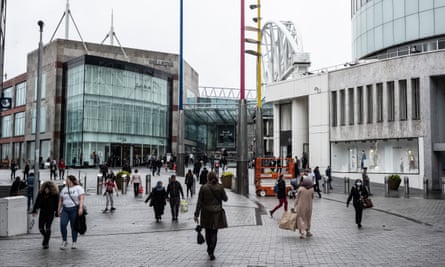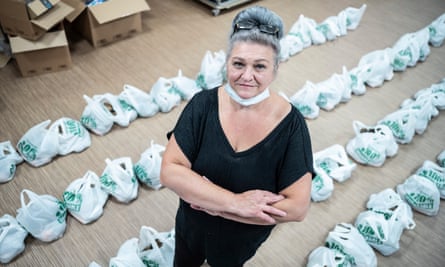In a near-deserted plaza near Birmingham’s Bull Ring shopping centre, local artist Diane Wiltshire considers the imminent return of traffic and pollution after lockdown with a feeling close to dread.
Wiltshire suffers chemical sensitivity – severe intolerance to pollutants, which give her breathing problems, affect her eyesight and disrupt her digestion. Doctors and immunologists are divided about the causes of her condition, but that makes little difference to the trauma felt by the 42-year-old as the old economy starts to rev up again.
“There is no way I want to go back to what was normal before,” she says. “I was very ill, but the lockdown has given me a break. I want those health improvements to stay.”
Wiltshire’s hypersensitivity is extreme, but it highlights the challenge facing the country as it emerges from an acute illness, Covid-19, that can kill in weeks, to return to a chronic illness, pollution, that erodes our health over years but on a far more destructive scale.

Amid the misery of the UK having the worst death toll from the coronavirus in Europe and growing fears about the economic impacts of the lockdown, people have also felt positive changes. In a nationwide YouGov-Cambridge Centre survey exclusively commissioned by the Guardian at the peak of the lockdown, 66% of respondents said air quality had improved, while 20% said there was no difference, and only 3% believed pollution had grown worse.
In the Midlands - where local NHS trusts have recorded some of the worst Covid-19 death tolls - there is both relief that the crisis may be easing but also nostalgia for the calm that some people got to experience by living and working at home, while the stress of capitalism was muted and there was a greater focus on collective wellbeing and community.
As elsewhere across the country, this has revitalised debate on whether to continue the trade-off between health and wealth, or whether to push for a green recovery that addresses both problems at the same time along with tackling the climate crisis.
Pollution hotspot
In this region, more than anywhere else in the UK, that means rethinking the road and air traffic industries that have long been a mainstay of the economy but are also a rising source of health concerns.
Until the lockdown, this West Midlands region registered several of the UK’s worst hotspots for pollution, most of which came from the exhaust pipes of the lorries and cars that zip by along the M5, M6 and M42 or crawl through the streets of Wolverhampton, Coventry and Birmingham. The street outside the Birmingham children’s hospital is among 10 areas in the city with levels of nitrogen dioxide that have risen above health guidelines in the past five years.
These fumes - along with the small particles from diesel engines - worsen asthma and other respiratory diseases, particularly in children, the elderly and among BAME and low-income communities who often live in more densely populated urban areas. They are also a contributory factor in heart disease and cancer. Some studies suggest polluted air reduces the lifespans of children born in Birmingham by up to seven months and may be a factor in the West Midland’s unwanted record as the worst place in the UK for infant mortality. Researchers are now examining whether poor air quality might also increase vulnerability to coronavirus.

Drive along those motorways and through city underpasses today and it is clear traffic is creeping back. At the height of the lockdown in March, the number of cars on the roads dropped to 1950s levels. Now it is probably closer to the 1990s and rushing forward. People have more reason to travel. The talk of Birmingham this week was the reopening of Primark.
Wiltshire has experienced a partial relapse but Birmingham, she says, could change for the better without cars. “You don’t need them here. This is the best city to cycle in. We have more trees than Paris and more miles of canals than Venice. If you cycle alongside, you feel safe, the air is cleaner and you might even see a kingfisher.”
As in many cities around the world, councils are creating more cycle paths and pedestrian areas, but these are often temporary and not everyone is mobile enough to use them. The best short-term hope for sustained air-quality improvements would be for as many people as possible to continue to work from home.
William Bloss, a professor of atmospheric science at Birmingham University, said the public had been given a demonstration that local-level action could make a big difference. “I think it has increased our appetite for change and society’s willingness to do things differently,” he said.
Birmingham was already planning to introduce a clean air zone in January. The West Midlands is also pioneering a project to install 5G air quality and traffic sensors on 1,000 road junctions. The city’s cultural hub, Birmingham Open Media, wants to use this data with an augmented reality phone app, #SelfAir, so that young people can visualise concentrations of particulate matter around them in fun, creative ways. The director, Karen Newman, aims to team up with schools across the region in a citizen science project that would allow children to monitor their neighbourhood’s pollution levels. “We want them to collectively pitch back to authorities what they want them to do,” she said.
Academics and campaigners say ambitious, urgent action is needed at a city and national level or traffic could return to higher levels than before. The half empty buses driving around Birmingham’s Chinatown highlight how public transport use has been subdued by physical-distancing rules and contagion concerns. This is pushing people back into cars, which suddenly seem like sanctuaries. The YouGov survey showed 28% of people planned to drive more than before lockdown, 16% less, while 52% expected no change. There is also anecdotal evidence in the city that people who did not previously have a car are now buying cheap second-hand bangers to commute to work. Meanwhile, big local employers Jaguar and Range Rover have seen such a fall in sales that they are struggling to survive, rather than rushing to invest in a low-carbon future.
But Bloss said the opposite was needed. “Encouraging a change in our vehicle fleets towards cleaner and electric vehicles could align with clean growth, air quality and public health, and reduced carbon emissions. It could also help levelling up efforts,” he said.
‘We know we’re going to be inundated’
The desperate need for an economic stimulus was evident in Bushbury, a former car manufacturing town in the Black Country. Even before the pandemic, this community, which has a high level of ethnic diversity, had some of the lowest income and highest debt levels in the UK. Now it is also one of the worst-affected areas for Covid-19 deaths in the country and is bracing for the financial impact on family budgets. Many people here were on zero-hours contracts in the care, security and retail sectors, which meant they were the first to be laid off.
At the community centre, charity worker Kim Payne works with volunteers to prepare more than 100 food parcels that are now distributed weekly to residents.

Over the past three months, the number of people seeking help at the community drop-in centre has tripled. This cosy hall, with its cafe and garden, was previously used for mental health counselling for teenagers and “feed your family on a fiver” cooking classes, but it has had to move activities online and start providing 300 food parcels a week plus 60 cooked meals for the elderly. Last week, for the first time, it launched an appeal for sanitary products after some local women said they could no longer afford period protection.
“We know we’re going to be inundated,” Payne said. “All those extra people who have got in touch online over the past few months will continue to need support for months.”
Clean air is little consolation for people here who have a week-to-week struggle to make ends meet. What is needed is employment and social security. Green growth could help.
The Local Government Association estimates 194,000 new clean jobs will be created in the Midlands - mostly in low-emission vehicle manufacturing - as the UK moves towards its goal of being carbon neutral by 2050.
Quick GuideWhat zero emissions in 2050 would mean for the UK
Show
The Committee on Climate Change says cutting greenhouse gas emissions to zero by 2050 is necessary, affordable and desirable. Here are some of the actions needed to make that happen:
• Petrol and diesel cars banned from sale ideally by 2030 and 2035 at the latest.
• Quadrupling clean electricity production from wind, solar and perhaps nuclear, plus batteries to store it and connections to Europe to share the load.
• Connection of new homes to the gas grid ending in 2025, with boilers using clean hydrogen or replaced by electric powered heat pumps. Plus, all homes and appliances being highly efficient.
• Beef, lamb and dairy consumption falling by 20%, though this is far lower than other studies recommend and a bigger shift to plant-based diets would make meeting the zero target easier.
• A fifth of all farmland – 15% of the UK – being converted to tree planting and growing biofuel crops and restoration of peat bogs. This is vital to take CO2 out of the air to balance unavoidable emissions from cattle and planes.
• 1.5bn new trees will be needed, meaning more than 150 football pitches a day of new forests from now to 2050.
• Flying would not be banned, but the number of flights will depend on how much airlines can cut emissions with electric planes or biofuels.
Leadership at a national level will be essential. Much is likely to depend on the economic recovery plan that Boris Johnson is expected to announce next month. The prime minister has indicated that green transport technology will be a key element. “The West Midlands was the home of the original automotive revolution, that’s where it all began, the internal combustion engine, and already in the West Midlands you’re seeing an incredible profusion of low carbon technology, low carbon vehicles,” he said earlier this month.
The government has already put £108m into the the UK Battery Industrialisation Centre which is due to open in Coventry later this year but such sums are trifling compared to the mega investments that Chinese and US firms have poured into battery “gigafactories”. Brexit has not helped. Nor has the UK’s tardy 2040 target date to halt sales of diesel and petrol cars. There is also a lack of strong targets on electric vehicles in the environmental bill that has been held up in parliament as a result of the pandemic. And for those who have tried to imagine an alternative, technological fixes and investments will not work without addressing deeper causes within our political, social and economic systems.
Roy Harrison, an air pollution expert at Birmingham University, said the opportunity could slip away. “If the public saw this as a real option, as a win win for improving the environment and stimulating the economy, we’d be a little healthier and leading the world in the mitigation of greenhouse gas emissions.” But he was sceptical that the lockdown would provide enough political impetus for action. “I’ve heard it so many times in the past. Once everything turns to normal, they won’t care an iota,” he said.
